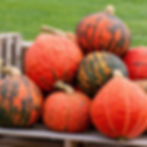Reisetomate Tomato seeds
Also known as the Reise, Journey, or Travel tomato, the Reisetomate is one of the most unique-looking varieties in the nightshade family. Believed to have origins in Peru, they are a sight to behold. They are best described as a cluster of cherry tomatoes that have fused together. In fact, you can tear each piece off one at a time, and eat them like cherry tomatoes. Each section holds its own seed cavity as well. The skin is thin and each section holds an intense tomato flavor and high acidity. Each tomato produced will weigh 2-4 ounces.
We have grown these 2 years in a row and we noticed they are a little more finicky to grow than other varieties. We also found they do a bit better in raised beds vs. containers.
Seed count: 10
Botanic name:
Solanum lycopersicum
Plant spacing:
24"apart
Color:
Bright red tomatoes, green foliage.
Sowing depth:
1/8" - 1/4"
Sun requirements:
Full sun
Utilization:
Hands down, one of the best snacking tomatoes. Each piece can be torn of individually and enjoyed.
Frost hardy:
No
Maturity days:
100-105 days
Life cycle:
Annual
Start indoors:
Yes
Container friendly:
Yes
Determinate or indeterminate:
Indetermiante
Growing Instructions:
**Growing Tomatoes from Seed :**
1. **Start Seeds Indoors:** Start seeds indoors 6-8 weeks before the last expected frost in your area. Use a seed starting mix and sow seeds about ¼ inch deep.
2. **Provide Light and Warmth:** Place the seed trays in a warm location with plenty of sunlight or under grow lights. Maintain a temperature of around 70-75°F, a germination mat works perfect for this.
3. **Water Regularly:** Keep the soil moist but not soggy.
4. **Transplant Seedlings:** When seedlings have 2-3 true leaves, transplant them into individual pots.
**II. Transplanting Tomato Seedlings/Plants:**
1. **Choose a Sunny Location:** Select a location with full sun (at least 6-8 hours of direct sunlight daily).
2. **Prepare the Soil:** Ensure the soil is well-draining and rich in organic matter. Amend with compost or aged manure.
3. **Harden Off Seedlings:** Gradually acclimate seedlings to outdoor conditions by placing them outside for a few hours each day, increasing the duration over a week.
4. **Dig Holes:** Dig holes slightly deeper than the root ball of the seedlings/plants. Space plants 2-3 feet apart depending on the variety.
5. **Plant Deeply:** Bury the stem up to the first set of true leaves, encouraging the development of additional roots.
6. **Water Thoroughly:** Water deeply after transplanting to help settle the soil around the roots.
**III. Caring for Tomatoes after Transplanting**
1. **Watering:**
* Water deeply and infrequently, aiming for about 1-2 inches of water per week.
* Water at the base of the plant to avoid wetting the leaves, which can encourage diseases.
* Water in the morning so the leaves have time to dry out before evening.
2. **Fertilizing:**
* Fertilize every 2-3 weeks with a balanced fertilizer formulated for tomatoes.
* Follow the instructions on the fertilizer label.
* Avoid over-fertilizing, which can lead to excessive foliage growth at the expense of fruit production.
3. **Staking or Caging:**
* Support tomato plants with stakes, cages, or trellises to keep the fruits off the ground and prevent the plants from sprawling.
* This also improves air circulation and reduces the risk of diseases.
4. **Pruning:**
* Prune indeterminate tomato varieties (those that continue to grow throughout the season) by removing the "suckers" - the small shoots that grow between the main stem and branches.
* This helps focus the plant's energy on fruit production.
* Determinate varieties (those that stop growing at a certain height) generally require less pruning.
5. **Mulching:**
* Mulch around the base of the plants with straw, shredded leaves, or other organic material.
* Mulch helps retain moisture, suppress weeds, and keep the soil cool.
6. **Pest and Disease Control:**
* Monitor plants regularly for signs of pests or diseases.
* Common pests include aphids, whiteflies, and tomato hornworms.
* Common diseases include blight, wilt, and blossom end rot.
* Take action promptly if you see any problems. Organic or chemical control options are available.
7. **Harvesting:**
* Harvest tomatoes when they are fully ripe and have reached their full color.
* Gently twist or snip the fruits from the vine.
* Enjoy your homegrown tomatoes!
**Additional Tips:**
* Consider planting different tomato varieties for a longer harvest season and a variety of flavors.
* Rotate your tomato planting location each year to help prevent soil-borne diseases.
* If you experience problems, consult your local garden center or extension service for advice.
With proper care and attention, you can enjoy a bountiful harvest of delicious homegrown tomatoes. Happy gardening!































